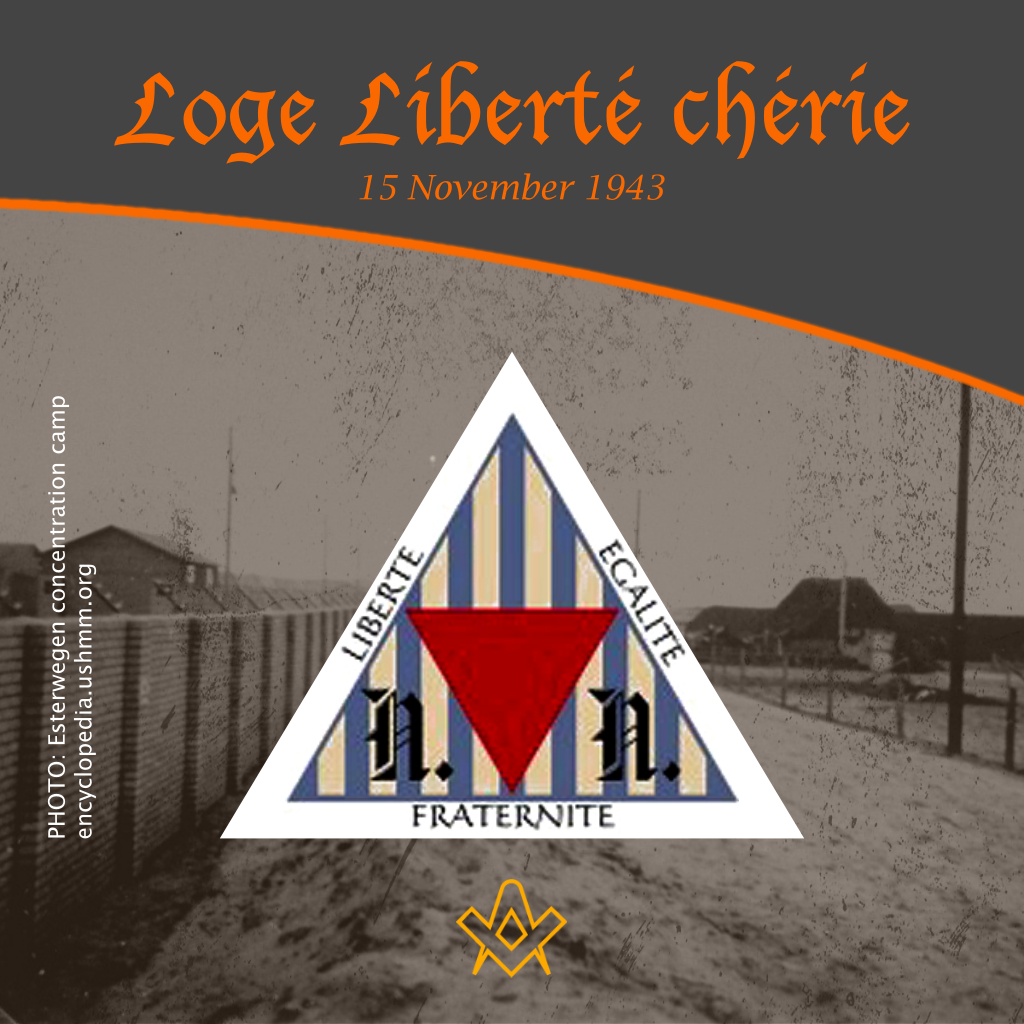Liberté chérie was a Masonic Lodge founded in 1943 by Belgian Resistance fighters and other political prisoners at Esterwegen concentration camp. It was one of the few lodges of Freemasons founded within a Nazi concentration camp during the Second World War.
In 1925, Adolf Hitler, the leader of Germany’s Nazi Party doubled down on enduring claims that the Jews were utilising Freemasonry to achieve their political end.
The Catholics had long used the rhetoric that during the eighteenth-century Freemasons were instrumental in being a threat to Church and State, with the French Revolution a testimony to their claims.
So, it was no surprise that in the following years, antisemitic and anti-Masonic sentiments continued to boil.
In 1903, sections of a text called The Protocols of the Elders of Zion, a fabricated antisemitic text was serialised in the Russian newspaper Znamya (The Banner).
Dangerously inflammatory, ‘The Protocols’ described a purported Jewish plan for world domination and built on previous works by Jesuit priests and antisemites whose narrative accused Enlightenment Freethinkers, Masons, and the Bavarian Illuminati of conspiring with the Jews to manipulate the global economy, politics, and religion for their own nefarious means.
Two years later it was published as an appendix to “The Great in the Small: The Coming of the Anti-Christ and the Rule of Satan on Earth”, another rabidly antisemitic text written by the Russian writer and mystic Sergei Nilus.
Russia at the time was involved in ethnic cleansing of the Jewish communities, antisemitic sentiment was high, so it was unsurprising that ‘The Protocols’ was not put under critical scrutiny and via various channels, was translated and rapidly spread to the wider world.
Even though the text was exposed by The Times of London as a fake, it was to have a catastrophic effect on both Jews and Freemasons.
In Hitler’s political diatribe “Mein Kampf”, he stated that:
To strengthen his [i.e., the Jew’s] political position, he tries to tear down the racial and civil barriers which for a time continue to restrain him at every step.
To this end he fights with all the tenacity innate in him for religious tolerance—and in Freemasonry, which has succumbed to him completely, he has an excellent instrument with which to fight for his aims and put them across.
The governing circles and the higher strata of the political and economic bourgeoisie are brought into his nets by the strings of Freemasonry, and never need to suspect what is happening.
In January of 1933, Hitler was appointed German Chancellor and within months the arrest of political opponents began.
On 20 March, SS leader Heinrich Himmler, announced the commencement of interment for political dissidents.
Even before the Holocaust of the Jews gained momentum, the Nazis had begun rounding up political prisoners from both Germany and German occupied Europe.
Most of the early prisoners were of two sorts: political prisoners of personal conviction or belief whom the Nazis deemed in need of “re-education” to Nazi ideals, or leaders of the Resistance movements in occupied western Europe.
Freemasons, alongside other “undesirables” such as Jews, the disabled, homosexuals, Roma gypsies, and the long list of political dissenters were to suffer an appalling fate. Millions were exterminated by the Nazis.
Those classified as political internees (including Freemasons), were distinguished within the camps by an inverted red triangle sewn on the tunic.
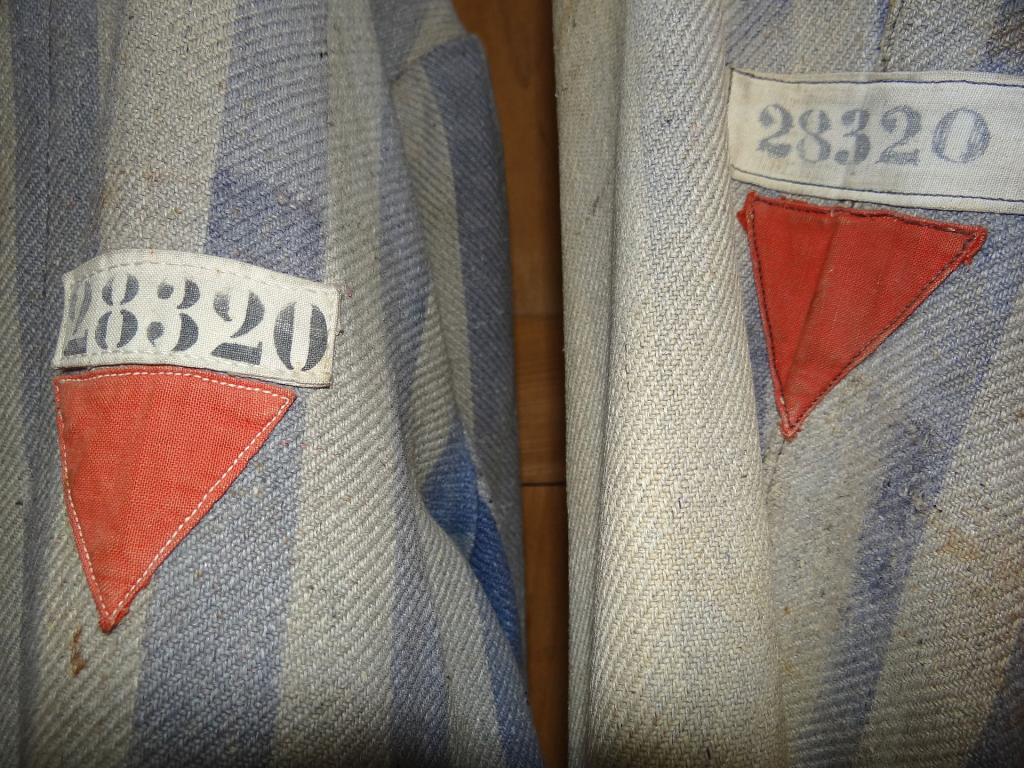
Image By Adam Jones, Ph.D. – Own work, CC BY-SA 3.0
IMAGE LINKED: wikimedia Attribution 4.0 International (CC BY 4.0)
The number of Freemasons sent to the camps and who never returned is estimated to be between 80,000 and 200,000.
The Nazis rejected Freemasonry, banning it in January 1934, partly because it was associated with Jews.
The secrecy associated with Masonic rituals has always made the organisation susceptible to conspiracy theories. The Nazis believed that the Freemasons were part of a conspiracy working against the interests of German nationalism. Criticism of Freemasons was a regular theme in Nazi propaganda – often framed in antisemitic discourse about the threat from ‘World Jewry’.
Thousands of Freemasons were persecuted by the Nazi regime and many were imprisoned in concentration camps, classed as political prisoners.
Source: Holocaust Memorial Day Trust
Between 1933 and 1945 the Nazi regime operated over a thousand concentration camps on its own territory and within German-occupied Europe.
It was in three of these camps that the only known Masonic lodges were founded and operated by inmates: Loge Liberté Chérie at Esterwegen in Emsland, Les Frères captifs d’Allach, in Allach, a camp annexed to Dachau, and L’Obstinée in Oflag X-D in Hamburg.
The first SS concentration camp was opened in Dachau near Berlin on 22 March 1933. From an initial count of 151 prisoners as of 31 March, the number rose swiftly to over 2000 by the end of June the same year.
Camps began to spring up across the country; the second camp opened after Dachau was in Esterwegan, located in the northwest Emsland district of Germany.
At its height in 1944, Esterwegen housed over two thousand so-called political Schutzhäftlinge (protective custody prisoners) and was for a time the second largest concentration camp after Dachau.
Officially, Esterwegen was not considered as a concentration camp but as a “Strafgefangenenlager” – “punishment camp for prisoners”.
Of course, the living conditions in this camp were the same as in the concentration camps: tortures, executions, forced work in the swamps until death, etc… One of the most famous prisoners of Esterwegen was the German writer Carl Von Ossietzky.
As pacifist and Nazi opponent, Carl von Ossietzky was jailed at Esterwegen several months after he received the Nobel Prize of Peace in 1936.”
Source: Jewish Virtual Library
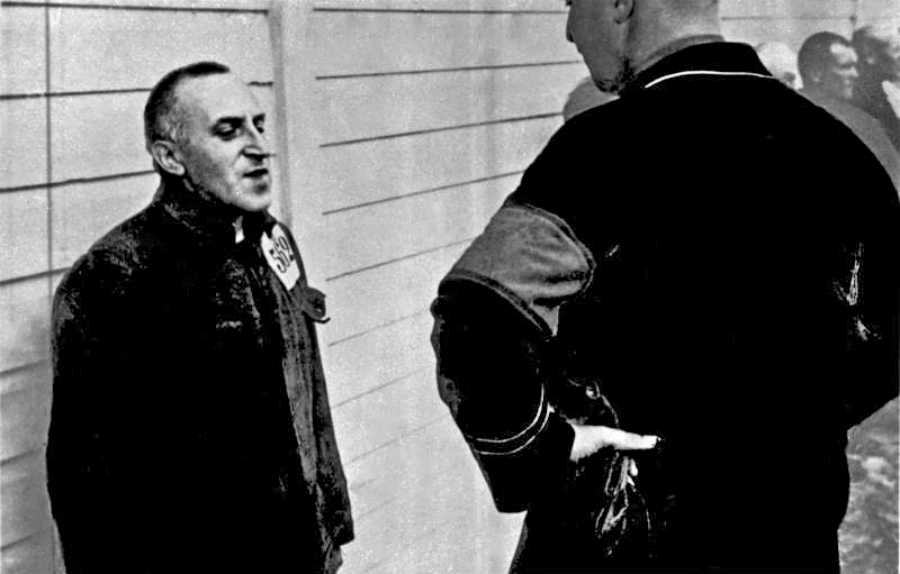
Carl von Ossietzky in Esterwegen concemtration camp, 1934. Credit: By Bundesarchiv, Bild 183-R70579 / CC-BY-SA 3.0, CC BY-SA 3.0 de
IMAGE LINKED: wikimedia Attribution 4.0 International (CC BY 4.0)
However, in December 1941, Hitler ordered a directive targeting political activists and resistance “helpers” in the territories occupied by Nazi Germany.
Known as the Nacht-und-Nebel-Erlass (“night and fog directive”) it did away with complying with the Geneva convention and abandoned “all chivalry towards the opponent” and removed “every traditional restraint on warfare.”
On 7 December 1941, Reichsführer-SS Heinrich Himmler issued the following instructions to the Gestapo:
After lengthy consideration, it is the will of the Führer that the measures taken against those who are guilty of offenses against the Reich or against the occupation forces in occupied areas should be altered.
The Führer is of the opinion that, in such cases, penal servitude or even a hard labor sentence for life will be regarded as a sign of weakness.
An effective and lasting deterrent can be achieved only by the death penalty or by taking measures which will leave the family and the population uncertain as to the fate of the offender.
Deportation to Germany serves this purpose.
The Three Historic Lodges
Three known Masonic lodges were created in the camps, sadly the information for L’Obstinée and Les Frères captifs d’Allach is not as extensive as for Liberté Chérie.
L’Obstinée
Aptly named, L’Obstinée (“The Obstinate”) was founded in the German prisoner-of-war camp Oflag XD.
The Lodge was founded by members of the Grand Orient of Belgium. Jean Rey, who would become President of the European Commission, was orator of the lodge. The Grand Orient of Belgium would recognize the Lodge on 14 July 1946.
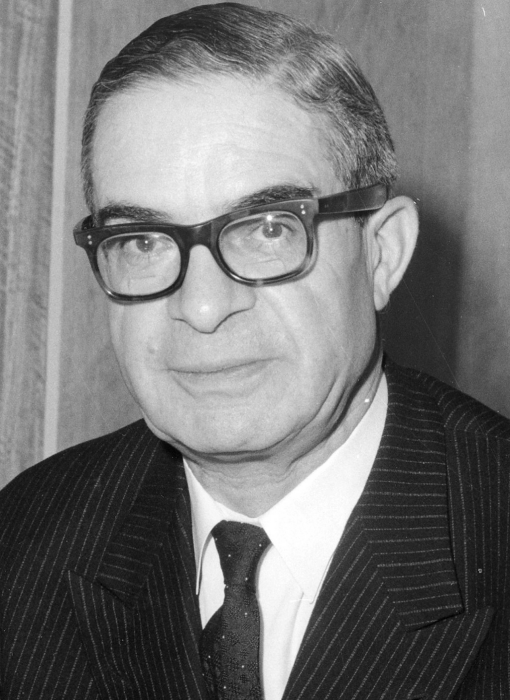
Jean Rey (1902-1983) By Marcelle Jamar – https://audiovisual.ec.europa.eu/en/photo-details/P-010705~2F00-1,
IMAGE LINKED: wikimedia Attribution 4.0 International (CC BY 4.0)
Les Frères captifs d’Allach (the captive brothers of Allach)
The lodge was created in Allach, a sub-camp annexed to Dachau. It was primarily used as a labour camp, established on February 22, 1943 to address workforce shortages in the armament and building industry of Nazi Germany.
Allach was considered the most important commando in the Dachau concentration camp. The deportees, of which numbered around 3850, worked there on various sites, mainly for the BMW factory.
On May 6, 1945, a group of Freemasons, including Georges Dunoir, created a Masonic lodge within the Allach camp.
One of the known members of the lodge was Georges Dunoir, a member of Le Coq enchaîné (The Chained Rooster) a resistance group in the region of Lyon, under the Vichy regime and under the German occupation.
Dunoir was arrested in 1942, deported to Dachau and then to Allach where he founded a lodge in May 1945, shortly after its liberation.
Source: Museum of Resistance
The Museum of Freemasonry in Paris has a vitally important piece of history concerning Les Frères captifs d’Allach – a register of the lodge workings.
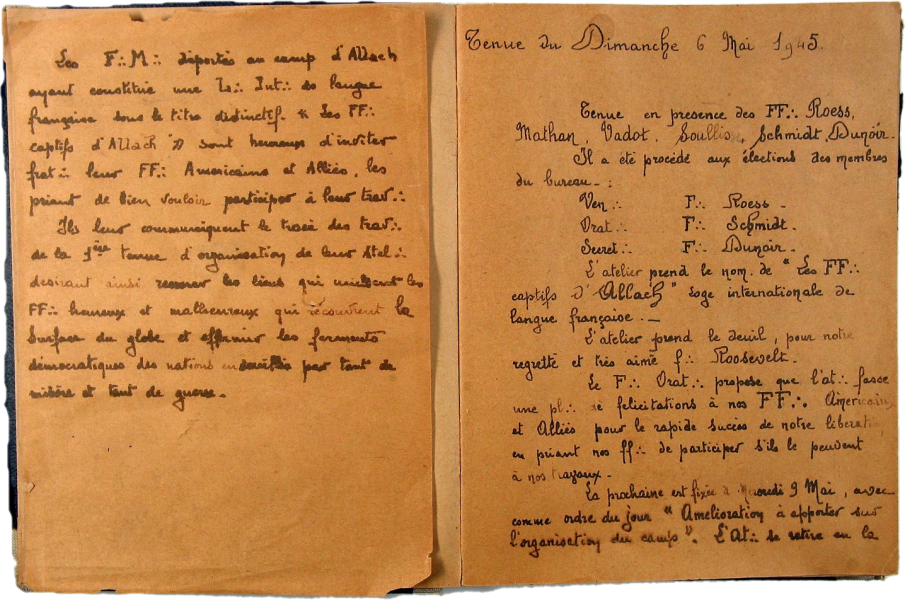
Book of architecture of the lodge Les Frères captifs d’Allach. This “French-speaking international lodge” was created in a prison camp in Allach, an annex of the Dachau camp. On May 6, 1945, after their liberation by the Allied forces, the brothers salute the memory of brother FD Roosevelt.
A lodge in a concentration camp, 1945 Paper, ink, 210 x 168 mm (open: 324 mm) Paris, Museum of Freemasonry. Num. Inv. P4.003
IMAGE CREDIT: © Museum of Freemasonry – all rights reserved.
The contents of the book explained:
The architecture book is a register that contains all the minutes of a Masonic meeting. The Freemasons use in their language and their rituals all the technical terms of architectural construction (example: the mason makes a board instead of saying that he is making a communication) while they appropriate the tools that they use as symbols of reflection for a personal construction (the compass, the square, the ruler, the plumb line, etc.).
This first page of the architecture book of the camp of Allach (kommando of Dachau) mentions the creation of an international lodge of French language which takes as name “Les Frères captifs d’Allach”.
During this founding meeting of May 6, 1945, the brothers Roess (Venerable), Schmidt (Speaker) and Dunoir (Secretary) were elected as members of the office.
It is important to point out that only two Masonic lodges have been identified within the concentration camps, the second, called “Darling Freedom”, having been founded by Belgian deportees at the Esterwegen camp.
This text contains many Masonic abbreviations. The abbreviation can be done in two ways: if the initial suffices for understanding, the initial of the word is written in capital letters and it is followed by three points in a triangle.
In other cases, in order to avoid any confusion, we use the first syllable of the word with a capital initial, followed by the first consonant and three dots in a triangle.
The abbreviations used in this document are as follows:
F ..M .. = Francs-maçons
L .. = Loge
Int .. = internationale
Frat.. = fraternellement
FF .. = frères
Trav.. = travaux
Atel .. = atelier (synonyme de loge)
Ven .. = Vénérable (président d’une loge)
Orat .. = orateur
Secret .. = secrétaire
(English Translation)
F ..M .. = Freemasons
L.. = Lodge
Int .. = international
Frat.. = fraternally
FF.. = brothers
Trav.. = works
Atel .. = workshop (synonymous with lodge)
Fri.. = Venerable (president of a lodge)
Orat .. = orator
Secret .. = secretary
During this meeting, the workshop pays homage to the American president, Franklin Roosevelt, who died on April 12, 1945, and who had joined Freemasonry in 1911.
Warm congratulations are then addressed to the American brothers and allies for “the rapid success of our liberation.
The brothers of the workshop then invite them to join in their work. The meeting ends with the agenda for the following meeting scheduled for Saturday, May 9, 1945 and having as its agenda “Improvement to be made to the organization of the camp”.
Source: Fabrice Bourree, www.museedelaresistanceenligne.org
Loge Liberté Chérie
However, of the three lodges created in the camps during those dark years, it is Loge Liberté Chérie that is the brightest light known to us.
Two surviving members and several witnesses were able to give their accounts, and after years of painstaking research their stories have been recorded for posterity.
Esterwegen Camp and the Arrivals at Barrack 6
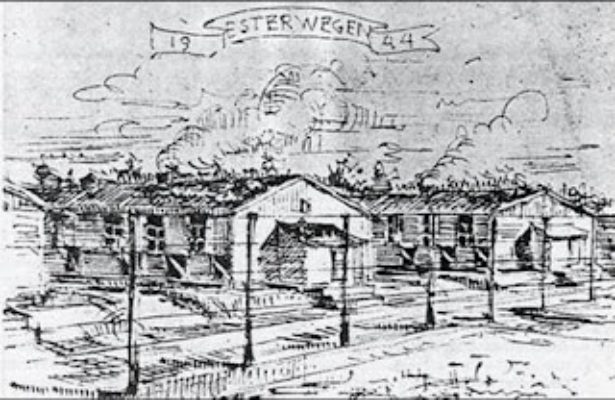
On Friday 21 May 1943, the first convoy of the NN (Nacht und Nebel/Night and Fog) political prisoners arrived at one of the Emslandlager camps .
Among the first arrivals at Emslandlager VII (Esterwegen) were members of the Belgian Resistance, amongst them were Franz Rochat, Jean Sugg, Guy Hannecart, Paul Hanson, and Fernand Erauw.
Four of the men (Rochat, Sugg, Hannecart and Hanson) were Master Masons, they were placed together in Barrack 6 at the camp.
As political dissenters (which included Freemasons) they would have been assigned the ‘red triangle’ emblem stitched to their uniforms.
At its height in 1944, the Esterwegen concentration camp housed over two thousand political prisoners from occupied Europe.
By some twist of fate, this small group of Belgian Freemasons found themselves in the same barrack.
They soon came together to form a group and when the number of Master Masons within the cramped hut reached seven, they were able to form a lodge.
A remarkable and highly dangerous achievement that would help the men bolster their resilience in horrendous circumstances.
An invaluable resource for information on the Lodge is to be found on a blog dedicated to Maurice Orcher (1919-1944), a Belgian Resistance fighter and martyr, executed by the Nazis. Maurice had been sent to Esterwegen along with fellow Belgian Franz Bridoux.
In 1941, Franz had joined the resistance organization the “Rassemblement National de la Jeunesse RNJ” – youth section of the Front de l’Indépendance – FI.
After mass arrests on resistance members by the Brussels Gestapo in 1943, he and Maurice found themselves in Barrack 6 at Emslandlager VII.
Bridoux escaped from a death march in 1945, and later contributed his testimony to the Maurice Orcher blog.
His full account of life in Barrack 6 and Loge Liberté Chérie was then published in his book “Liberté Chérie in Nacht und Nebel Gründung einer Freimaurerloge im KZ Esterwegen” (“Liberté Chérie in night and fog – Founding of a Masonic lodge in the Esterwegen concentration camp”).
Franz Bridoux recalls that Barrack 6 was occupied by:
…national and regional leaders of the RNJ, Freemasons, Socialists, Catholics, who were also later joined by French prisoners who were members of the FTPF (francs-tireurs partisans français)
…the simple wooden barracks divided into zones: the refectory, the dormitory and the toilets. The tables are organized into groups J (for RNJ), K (for Catholics), S (for socialists), and Freemasons
…the groups are reconstituted, and life is organized around large tables.
The work there is useless and humiliating, we sort casings that the Germans mix again in the evening.
The food is insufficient and the prisoners lose 5 kg per month.”
Translated from the French
More than a hundred prisoners were in Barrack 6 and locked up nearly around the clock — allowed to leave only for a half-hour walk per day, under supervision.
During the day, half of the camp had to sort cartridges and radio parts; at the end of the day, the guards would throw all the sorted parts into one box and the prisoners would sort them again – a pointless and dehumanising task.
The prisoners in the other half of the camp were forced to work under dreadful conditions in the surrounding peat bogs.
Franz was only 20 years old and had no previous knowledge of Freemasonry.
However, he quickly became friends with the Freemasons who shared table 3 with him, his companions from the National Committee of the RNJ and other French prisoners who were members of the FTPF (francs-tireurs partisans français).
“At Table 3, several FMs are present: L. Somerhausen, P. Hanson, G. Hannecar, F. Rochat, J. Sugg and A. Miclotte.
Also present are members of the RNJ: S. Goldberg, F. Lecoq, J. Lagneau, A. Verneirt, A. Steux and J. Berman.”
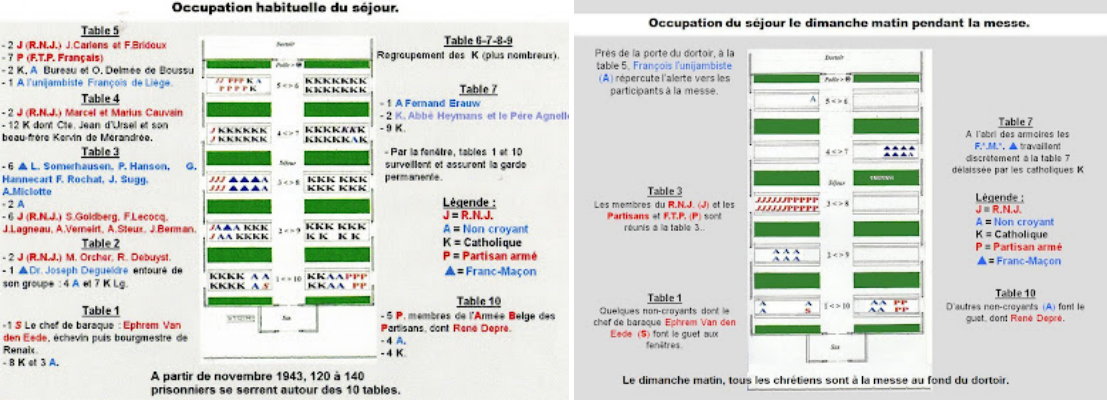
Franz continues:
In the barrack there are soldiers, civil servants, doctors, lawyers, journalists, priests, teachers, students, merchants, workers, aristocrats ….
The grouping at the tables is done by linguistic affiliation, by affinity and by organization of resistance.
Catholics tend to get closer to priests and in the evening chant collective prayers aloud. Believers are much more numerous and on Sunday mornings, they meet at the back of the dormitory for mass.
Non-Catholics and non-believers stand guard and serve as screens for believers.
Although not a member of Loge Liberté Chérie, Franz witnessed the workings of the lodge, held at one of the tables whilst the Mass was taking place; the area was “relatively isolated thanks to the cupboards which separate them.”
The Catholics shielded the Masons and vice versa; in adversity there was no distinction, no prejudice, nor intolerance.
It was testimony to the principles of Freemasonry, that all should be equal, on the level.
The humanity and compassion of the inhabitants of Barrack 6 transcended the external hate and intolerance that was sweeping Europe.
Cherished Liberty
The second convoy of inmates arrived on May 28, 1943. As new prisoners arrived, so did the number of Freemasons increase until there was the requisite seven Master Masons to create a lodge.
It was the arrival of Master Mason Amédée Miclotte that finally allowed the lodge to be formed, and on 22 November 1943, within the darkness of a Nazi prison camp was born the light of Liberté Chérie – “Cherished Liberty”.
They chose the name partly in reference to the French national anthem La Marseillaise, an appropriate choice in more ways than one as the song had its roots in Freemasonry – and of course, liberty.
Around 24/25 April 1792, Freemason Captain Rouget de Lisle Baron, was the guest of Philippe-Frédéric de Dietrich, mayor of Strasbourg and worshipful master of a local Masonic lodge.
At Dietrich’s behest Rouget de Lisle Baron wrote “Chant de guerre pour l’Armée du Rhin”(English: “War Song for the Army of the Rhine“), and dedicated the song to Marshal Nicolas Luckner, a Bavarian freemason – a song to “rally our soldiers from all over to defend their homeland that is under threat”.
That song would soon become the Republican anthem of the French during the Revolution.
Another reason the name of the lodge was chosen was to honour the protest song “Die Moorsoldaten” – the Peat Bog Soldiers, a song written in 1933 in the nearby Emsland camp of Börgermoorby by Communist prisoners Johann Esser (a miner) and Wolfgang Langhoff (an actor); the music was composed by Rudi Goguel.
It was first performed by the prisoners at a Zircus Konzentrani (“concentration camp circus”) on 28 August 1933 and soon became a favourite of oppressed workers throughout Europe.
The song has a slow simple melody, reflecting a soldier’s march, and is deliberately repetitive, echoing and telling of the daily grind of hard labour in harsh conditions.
The “Le Chant des Marais” is the French translation of “Die Moorsoldaten”.
Full Members of Loge Liberté Chérie
Paul Hanson (1889 – 1944) Lodge Master and Founder Member – Justice of the Peace in the canton of Louveigné, active in an intelligence and action service and member of the Loge Hiram in the Orient of Liège. Hanson was moved from Esterwegen to one of the camps in Essen, and died in the rubble of his prison, during the Allied air bombardment on Essen, on March 26, 1944.
Luc Somerhausen (1903–1982) Founder Member – Somerhausen was journalist, was born on 26 August 1903, in Hoeilaart. He was arrested on 28 May 1943 in Brussels. He belonged to the lodge Action et Solidarité No. 3 and was deputy secretary of the Grand Orient of Belgium. As Luc knew the Masonic procedure to follow, he was instrumental in the creation of Loge Liberté Chérie, as writer of the statutes. After liberation, he obtained official recognition of the lodge from the Grand Orient of Belgium. Luc died in Brussels on April 5, 1982.
Jean Sugg (1897-1945) Founder Member – born in Ghent and was of Swiss German origin. He co-operated with Franz Rochat in the underground press, translated German and Swiss texts, and contributed to clandestine publications, including, La Libre Belgique, La Légion Noire, Le Petit Belge, and L’Anti Boche. Jean belonged to the Philanthropic Friends Lodge Les Amis Philanthropes, Lodge No. 5 of the Grand Orient of Belgium. He died in Buchenwald concentration camp on May 6, 1945.
Jean De Schrijver (1893- 1945) Founder Member – a colonel in the Belgian Army. He was born 23 August 1893 in Aalst, and was a brother of the lodge La Liberté in Ghent. On 2 September 1943 he was arrested on charges of espionage and possession of arms, he died in February 1945.
Amédée Miclotte (1902-1945) Founder Member – a high school teacher. He was born 20 December 1902 in Lahamaide, and belonged to the lodge Union et Progrès. He was last seen in detention on 8 February 1945.
Franz Rochat (1908-1945) Founder Member – a professor, pharmacist, and director of an important pharmaceutical laboratory, was born on 10 March 1908 in Saint-Gilles. He was a worker in the underground press, and the resistance publication Voice of the Belgians. He was arrested on 28 February 1942, arrived at Untermaßfeld in April 1944, and died there on 6 April 1945. He belonged to the Philanthropic Friends lodge les Amis Philanthropes, Lodge No. 5 of the Grand Orient of Belgium.
Guy Hannecart (1903–1945) Founder Member – a lawyer and leader of La Voix des Belges. He was also member of the lodge les Amis Philanthropes. Guy died in Bergen-Belsen on April 25, 1945.
Joseph Degueldre (1904-1981) doctor, member of “Travail” lodge of Verviers and member of the Secret Army (Belgium). He was seated at table 2 with a group of resistance fighters from his region but participated in the work of the lodge on Sunday mornings.
Fernand Erauw (1914-1997) – an assessor at the Audit Office, and reserve officer with the Infantry, was born on 29 January 1914, in Wemmel. He was arrested on 4 August 1942, as a member of the Secret Army. He escaped and was finally arrested in 1943, arriving at Esterwegen. Initiated into lodge Liberté Chérie soon after.
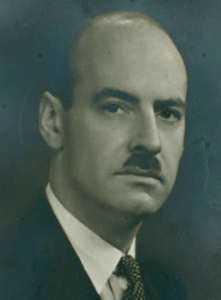
Henri Story (1897-1944) – a Belgian businessman and liberal politician from Ghent, Belgium. His work for the underground resistance during the war would lead to his capture and death. On 22 October 1943 he was arrested in his office at the Kouter in Ghent. Attempts to get him released failed and in March 1944 he was transported to Germany. Story died in a camp at Gross-Rosen near Breslau on 5 December 1944.
From Franz Bridoux’s testimony:
Luc Somerhausen described Erauw’s initiation, etc., as just simple ceremonies. These ceremonies (in the maintenance of the secrecy of which, they asked the community of Catholic priests for assistance, “with their prayers”) “took place at one of the tables
…after a very highly simplified ritual—whose individual components were however explained to the initiate; that from now on he could participate in the work of the Lodge”.
After the first ritual meeting, with the admission of the new brother, further meetings were thematically prepared. One was dedicated to the symbol of the Great Architect of the Universe, another to “the future of Belgium”, and a further one to “the position of women in Freemasonry”.
Only Somerhausen and Erauw survived detention, and the lodge stopped “working” at the beginning of 1944.
The Survivors
From Franz Bridoux’s testimony it is known that Erauw and Somerhausen survived. They were moved from Emslandlager VII, but met again in 1944 at Sachsenhausen concentration camp and remained inseparable from then on.
In 1945, as the Germans faced defeat, prisoners were moved via death marches from the camps to evade the approaching Allied Forces. Miraculously Somerhausen and Erauw survived the ordeal. After repatriation, Erauw, although 1.84 m tall, weighed only 32 kg on 21 May 1945 when treated in the Saint Pierre Hospital in Brussels.
In August 1945, Luc Somerhausen sent a detailed report to the Grand Master of the Grand Orient of Belgium, in which he delineated the history of the lodge. It was through his testimony that official recognition by the Grand Orient of Belgium was obtained for Loge Liberté Chérie. Somerhausen died in 1982 at the age of 79.
Fernand Erauw died at the age of 83, in 1997. Up until his death, Fernand Erauw’s wish was for us to relentlessly track down “all forms of oppression, all forms of negation of the human being, all cowardice, all fascism, all totalitarianism…”
Doctor Joseph Degueldre also survived; he died in Pepinster, Belgium in 1981 where there is a plaque dedicated to him.
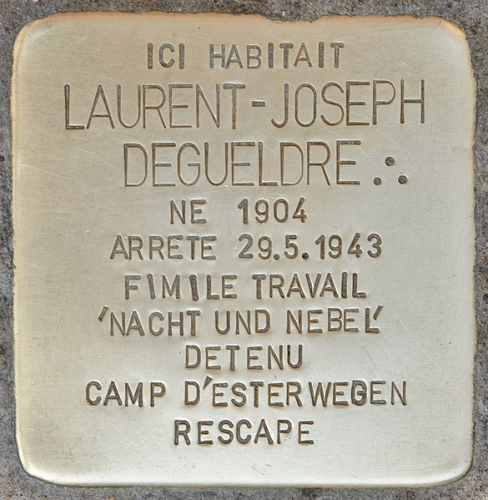
Stolperstein für Laurent-Joseph Degueldre. Photo: Christian Michelides
IMAGE LINKED: wikimedia Attribution 4.0 International (CC BY 4.0)
In the spring of 1945, Franz Bridoux and three other regional leaders of the RNJ: Joseph Berman, Marius and Marcel Cauvain were transferred to the prison of Ichtershausen (Thuringia).
Shortly after they were sent on a death march towards the mountains of Upper Silesia.
They escaped together to Pösneck on 11 April 1945, where they were liberated by the American army on April 15 and repatriated on 7 May 1945.
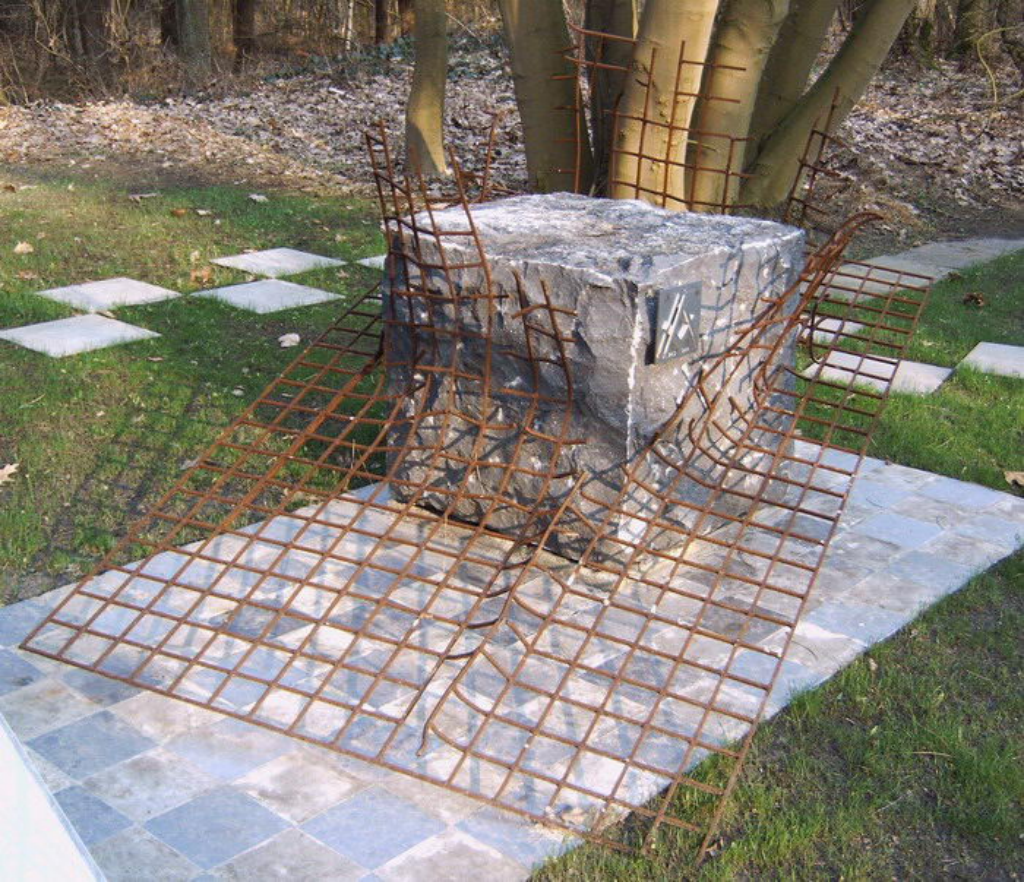
Masonic Memorial at Esterwegen. By de:user:Marvins21
IMAGE LINKED: wikimedia Attribution 4.0 International (CC BY 4.0)
A memorial dedicated to those brave men, created by architect Jean de Salle, was raised by Belgian and German Freemasons on 13 November 2004. It is now part of the broader site of the Esterwegen Memorial, a place ofremembrance for all 15 Emsland camps and their victims.
Wim Rutten, the Grand Master of the Belgian Federation of the Le Droit Humain gave the following address:
We are gathered here today on this Cemetery in Esterwegen, not to mourn, but to express free thoughts in public.” – “In memory of our brothers; human rights should never be forgotten.
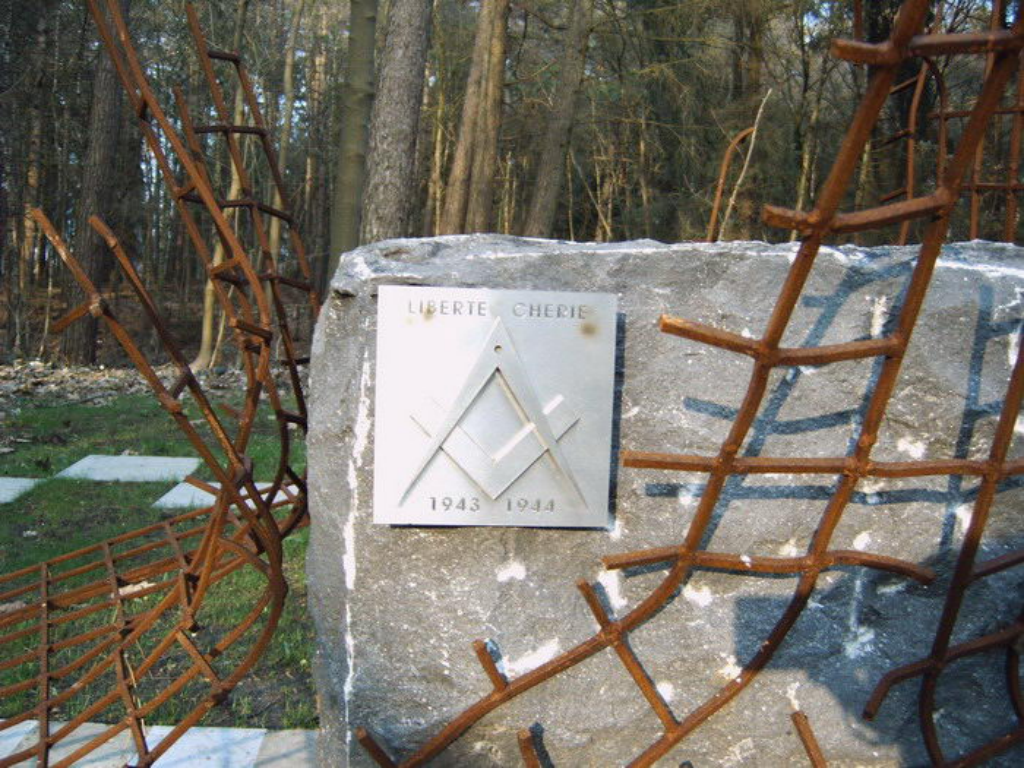
Remembering Liberté Chérie and its members – 1943-1944 By de:user:Marvins21 – de.wikipedia.org
IMAGE LINKED: wikimedia Attribution 4.0 International (CC BY 4.0)
Franz Bridoux – the man who lifted the fog
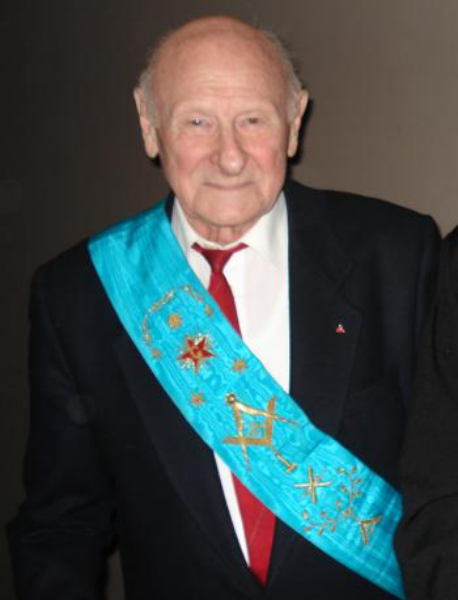
Franz Bridoux (1924-2017)
IMAGE LINKED: wikimedia Attribution 4.0 International (CC BY 4.0)
Franz Bridoux became a Freemason after the war, he died on 14 January 2017 at the age of 94. Read a memorial here from the Masonic blog Under the Starry Vault, and view his incredible testimonies on YouTube.
Témoignage de Franz Bridoux – Part 1 video interview
Témoignage de Franz Bridoux – Part 2 video interview
Au camp de concentration d’Esterwegen – Franz Bridoux
“Nuit et Brouillard” au camp de concentration d’Esterwegen. Travail de mémoire de Franz Bridoux.
Musique : “Le Chant des Marais”.
Under the Starry Vault blog made a moving tribute to Franz, with images from his book, and the song “Le Chant des Marais”.
Acknowledgments:
Grateful thanks goes to Samy Benoudiz (Maurice Orcher – Resistant and Martyr blogspot) for permission to use text and images from Franz Bridoux’s testimony.
Further Reading
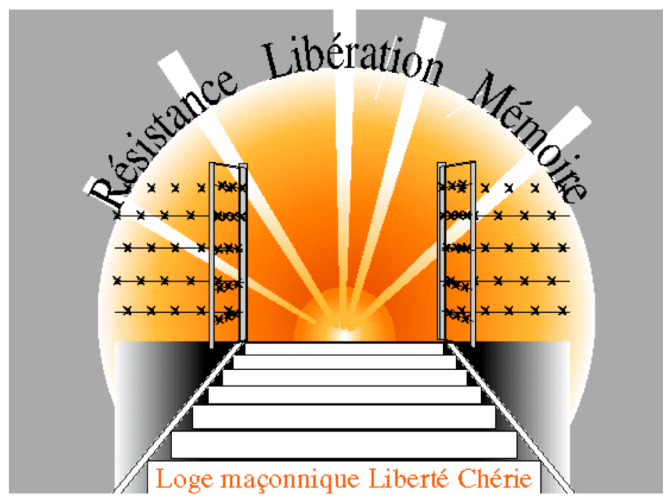
Fernand Erauw: L’odysée de Liberté Chérie, 1993 — History of this Lodge (in French) PDF
Source: Masonic site Acacia.fm, now defunct. This site was in its time organized by René Louis LESIMANT.
It is the extraordinary story of prisoners, during the 1940-45 war, in German concentration camps, interned for acts of resistance in the NN category (“Nacht und Nebel”), who recognize each other as being Franks- Masons…
The rest is told to you by Fernand ERAUW, the only Mason initiated in the Nazi camps, during his very captivity.
Footnotes
Referances
Sources:
Maurice Orcher – Resistant and Martyr
This blog was created by the family and friends of Maurice Orcher, to perpetuate his memory.
http://mauriceorcher.blogspot.com/2009/01/cration-de-la-loge-libert-chrie-au-camp.html
Musee de la Resistance www.museedelaresistanceenligne.org
BnF http://expositions.bnf.fr/franc-maconnerie/grand/frm_195.htm
Wikipedia contributors, “Liberté chérie,” Wikipedia, The Free Encyclopedia, https://en.wikipedia.org/w/index.php?title=Libert%C3%A9_ch%C3%A9rie&oldid=1059712853 (accessed December 27, 2022).
Wikipedia contributors, “Esterwegen concentration camp,” Wikipedia, The Free Encyclopedia, https://en.wikipedia.org/w/index.php?title=Esterwegen_concentration_camp&oldid=1084910345 (accessed December 27, 2022).
Wikipedia contributors, “Nacht und Nebel,” Wikipedia, The Free Encyclopedia, https://en.wikipedia.org/w/index.php?title=Nacht_und_Nebel&oldid=1097326677 (accessed December 27, 2022).
Wikipedia contributors, “L’Obstinée,” Wikipedia, The Free Encyclopedia, https://en.wikipedia.org/w/index.php?title=L%27Obstin%C3%A9e&oldid=933799092 (accessed December 27, 2022).
Article by: Philippa Lee. Editor

Philippa Lee (writes as Philippa Faulks) is the author of eight books, an editor and researcher.
Philippa was initiated into the Honourable Fraternity of Ancient Freemasons (HFAF) in 2014.
Her specialism is ancient Egypt, Freemasonry, comparative religions and social history. She has several books in progress on the subject of ancient and modern Egypt. Selection of Books Online at Amazon

LA RESPECTABLE LOGE LIBERTE CHERIE AU CAMP DE CONCENTRATION D’ESTERWEGEN.
(French Edition)
By: Franz Bridoux
Lorsque l’on évoque la Loge Liberté Chérie, les adjectifs fleurissent : extraordinaire, unique, incroyable, exceptionnel.
Franz à l’automne de sa vie écoute, lit les commentaires et les articles de presse. L’intérêt du public pour cette histoire grandit. Les publications sont des succès.
En Allemagne, en France, en Belgique on se passionne pour ce récit. Tous les ingrédients d’une bonne histoire sont là : le bien, le mal, la résistance au totalitarisme, un idéal, une audace ultime.
La génération des témoins directs de la Seconde Guerre mondiale a disparu. Les témoignages écrits ou enregistrés ont donc toute leur importance.
Celui de Franz Bridoux est à cet égard particulier. Il fut le dernier témoin d’un épisode unique de l’Histoire maçonnique : la création de la Loge Liberté Chérie créée en novembre 1943 dans le camp de concentration Emslandlager VII d’Esterwegen.

Freimaurerloge im KZ Esterwegen
(German Edition)
By: Franz Bridoux
Im Frühjahr 1943 begegnen sich in einer elenden Baracke des Konzentrationslagers Esterwegen einige Freimaurer.
Trotz des großen Leids, der ruinierten Gesundheit und schlimmster Schikanen finden sie gemeinsam den Mut, sich zu einem Bruderkreis zusammenzuschließen.
Sie gründen die gerechte und vollkommene Loge “Liberté Chérie” und nehmen die freimaurerische Arbeit unter den unglaublichsten Umständen auf. Sie setzen ein Zeichen der Hoffnung gegen das grausame Nazi-Regime.
Als der damals 19-jährige Belgier Franz Bridoux von den Besatzern 1943 zur Zwangsarbeit nach Deutschland geschickt werden soll, taucht er als Fahnenflüchtiger unter.
Er wird Mitglied der Widerstandsbewegung. Nach seiner Festnahme deportieren ihn die Nazis als “Nacht-und-Nebel-Häftling” in das KZ Esterwegen. Der Bericht eines der letzten Augenzeugen ist ein Dokument des Mutes, der Aufopferung und der Hoffnung.


Loge Liberté chérie: A Light in the Darkness
By: Alexander P. Herbert
At its height in 1944, the Esterwegen concentration camp housed over two thousand political prisoners from occupied Europe.
Among them was a small band of Belgian Freemasons who, by chance or providence, found themselves assigned to the same barrack.
In the midst of these terrible conditions, they came together to form the secret Masonic Lodge Liberté chérie. Years of painstaking research and translation have yielded, for the first time, a comprehensive telling of these events for English readers.
It is a story that transcends personal differences and the borders of Masonic jurisdiction. This camaraderie and compassion laid the foundation for the most important work in the history of the world’s oldest Fraternity.
Recent Articles: history series
 Narratives of History |
 A Very Royal Sesquicentenary |
 Unveiling the Enigma: Discover the Royal Society's Legacy and its Impact on Science. Delve into the fascinating history of the Royal Society, the prestigious UK academy shaping scientific progress since 1660. Explore its pivotal role in advancing knowledge, fostering collaboration, and unlocking the secrets of the universe. Prepare to be amazed! |
 Knights Templar in Freemasonry Uncover the Mysteries of the Knights Templar in Freemasonry! Delve into the intriguing world where chivalry and symbolism intertwine. Discover the captivating rituals and ancient secrets behind the Knights Templar Masonic Orders. Explore the historical connection and delve into the enigmatic narratives that continue to fascinate enthusiasts today. Unveil the hidden truths now! |
 The Royal Arch stands as the rainbow of promise in the Ritual; it stands as the promise of the resurrection; of that which was lost and that it shall be recovered. The question arises as to whether the Master's Word was originally communicated in the Third Degree? On this point there is some diversity of opinion. Originally published in 1915, this insight into the Fourth Degree – the Holy Royal Arch – is as relevant today as it was over 100 years ago. |
 Unveiling the Mysteries of Druidism: Discover the Intriguing Connection with Freemasonry. Explore the ancient spiritual practice of Druidism and its fascinating ties to the enigmatic world of Freemasonry. Delve into the shared symbolism and rituals that have captivated minds for centuries. Unlock the secrets of these intertwined traditions today! |
 Uncover the legacy of freestone masons and their pivotal role in crafting medieval cathedrals. Discover the artistry behind their techniques, the hierarchy within their craft, and the enduring impact of their intricate carvings. A deep dive into the world of these master craftsmen awaits you! |
 Unearth the intriguing journey from Vincha Culture to Freemasonry. Discover how ancient building methods intertwine with modern Masonic philosophies. This exploration will shed light on the fascinating link between the Serbian term "shestarenye" and the symbolic significance of the compass in Freemasonry. |
 Freemasonry and the Illuminati Unravel the enigmatic world of Freemasonry and the Illuminati in our latest exposé. Dive into centuries-old mysteries, debunk conspiracy theories, and discover the truth behind these elusive societies. Are they puppet masters or mere myths? Join us as we dissect history and fact from fiction. |
 The Île des Templiers, or “Island of the Templars” lies within a leafy park in Paris. The execution site of Jacques du Molay, the last Grand Master of the Knights’ Templar bears a plaque with the epitaph ‘A cet endroit / Jacques de Molay / Dernier grand maître / de l'ordre du temple / a été brûlé le 18 Mars 1314’ (‘In this location / Jacques de Molay / Last grand master / of the order of the temple / was burned on 18 March 1314’) |
 Operative Progressions to Speculative Masonry Both Operative and Speculative Masonry are an important part of the modern fraternity of Freemasonry, which combines elements of both traditions. Today, Freemasonry is a fraternity that is open to men of good character, who are interested in personal development and in making a positive contribution to their communities. |
 General Regulations of a Free Mason, 1723 General Regulations of a Free Mason as contained in Anderson's Constitutions of the Freemasons, published 1723. the Regulations are of great historical interest. Compiled by George Payne, the second Grand Master of the Premier Grand Lodge of England, they were printed in 1722/3, thus published just over five years after the formation of the Grand Lodge 1717. |
 The Genesis of the 1723 Book of Constitutions 2023, marks the three hundredth anniversary of the publication of the first printed Book of Constitutions of the Grand Lodge formally established in London two years previously. This is an anniversary whose significance extends beyond freemasonry. A paper by Andrew Prescott |
 The Ritual of the Operative Free Masons - P3 Existing Operative Free Masons. The ritual I am about to refer, is that of "The Worshipful Society of Free Masons, Rough Masons, Wallers, Slaters, Paviors, Plaisterers, and Bricklayers." By Thomas Carr, M.D., P. M. Honorary Member of the Guild of Operative Free Masons |
 Liberté chérie was a Masonic Lodge founded in 1943 by Belgian Resistance fighters and other political prisoners at Esterwegen concentration camp. It was one of the few lodges of Freemasons founded within a Nazi concentration camp during the Second World War. |
 The Ritual of the Operative Free Masons - P2 If anyone doubts the fact that the formation of Speculative Free Masonry was due to and based upon Operative Free Masonry, it is quite easy to convince him of his error if he will only study the first Book of Constitutions. By Thomas Carr, M.D., P. M. Honorary Member of the Guild of Operative Free Masons |
 In 1881, Freemasonry rose from the ashes of a fire in the mining town of Kokomo, Summit County, Colorado. Corinthian Lodge No. 42, along with Kokomo, no longer exists but it holds the record of having been – at an elevation of 10,618 feet – the highest Masonic Lodge in the USA. |
 The Huguenots and Early Modern Freemasonry The Huguenots influence in the development of early modern Freemasonry at the time of the formation of the Grand Lodge in London around 1717 / 1723. |
 November is a month of reflection – perhaps due to the fact that we are getting close to the years' end – but also because Remembrance / Armistice Day (11 November) is a significant date in most countries' diaries. |
 Speculative Freemasonry, as practise by Grand Lodge of England, was officially born just over three hundred years ago, is today an international organisation, counting over six million members. It has been subjected to persecution, suppression, and abolition throughout its history. In its infancy, only a couple of decades after its official birth, it had already become a target. |
 The Ritual of the Operative Free Masons - P1 The original paper was written, first, to prove that Speculative Free Masonry was derived from Operative Free Masonry; second, to give some account of the Operative Free Masons, of their Ritual, and of their customs. By Thomas Carr, M.D., P. M. Honorary Member of the Guild of Operative Free Masons |
 American Fraternalism in the 19th and Early 20th Centuries The late 19th and early 20th centuries in the United States has been called the "Golden Age of Fraternalism." How did this come about and why was the idea of joining a fraternal organization so popular? We will explore this question and examine the regalia used by many fraternal organizations in this period. |
 Societas Draconistarum, meaning "Society of the Dragonists"– was a chivalric Order for selected nobility, founded in 1408 by Sigismund von Luxembourg, who through marriage became the King of Hungary (1387–1437) and later Holy Roman Emperor. The Order was fashioned after the military orders of the Crusades, requiring its initiates to defend the cross and fight the enemies of Christianity, in particular the Ottoman Empire. |
 The Perjured Free Mason Detected Was Samuel Prichard a perjured individual, or simply a misguided Freemason? Prichard's book "Free Masonry Dissected" published in 1730, is now used by many Masonic historians as a source of reference with regards to the introduction of the third degree into the Craft. But at the time it was published in 1730, it was not so well received by members of the Grand Lodge of England. |
 17th century and the Holy Royal Arch This article focuses on a period of transition between a point in time when we can safely and historically identify the first formation of what could be called as the ‘Royal Arch’ and the historical events that have preceded it. |
 Most Freemasons have heard the terms 'Operative' and 'Speculative' Masons, and this article helps to understand the difference: |
 Roberts' Constitutions of Freemasonry 1722 Published a year before Anderson's Constitutions, The Old Constitutions Belonging to the Ancient and Honourable SOCIETY OF Free and Accepted MASONS. Originally printed in London England; Sold by J. Roberts, in Warwick-Lane, MDCCXXII.(1722) |
 From 'Songs of religion and life', 1876 by John Stuart Blackie (1809-1895) |
 On the Antiquity of Masonic Symbolism Is the Symbolism of Masonry an inheritance derived from the old Masons who flourished before the era of the Grand Lodges (1717); or has it been borrowed from the Rosicrucians or others, after 1717? |
 Mason's Marks – from Egypt to Europe? Mason's marks have been a source of intrigue, not only to Freemasons but to historians and archaeologists. The use of simple pictograms have been employed for millennia by artisans to identify their work. But where did they originate and why? |
 The White House Foundation Stones Further to the articles in our series on the history of the stone masons, we have a rather intriguing addition. During the 1950's renovation of the White House, President Truman retrieved more than 100 stone blocks with stonemasons marks. |
 What the Goose and Gridiron Tavern is in the ancient annals of London Freemasonry, The Green Dragon Tavern is to the memories of the Free-mason, of Boston and New England. |
 Auschwitz concentration camp: video photo article taken in 2013 |
 There are two things of importance happening this day - 27 January |
 Two approaches regarding the understanding of Freemasonry |
 Masonic Research in England c1930 An article which appeared in an American Masonic magazine, c1930 and which was reproduced in England, provoking a little controversy. |
 Masonic bookplates the ‘Brethren’s spiritual coats of arms and marks’ |
 The Unlawful Societies Act of 1799 Rebellious Freemasons and the 21st century |
 In 1912, Sarah Dowd of Dromore, Ireland, found a Masonic jewel dated 1517 - a date two hundred years before the establishment of Grand Lodge... |
 Freemasonry and Fascist Regime Interesting speech by the famous historian Prof. Aldo A. Mola, who links the fascist regime with the Masonic Associations. |
 Was famous Russian poet Alexander Pushkin a Freemason? And if so, was he a member of the lodge ‘for which all the lodges in Russia were destroyed’? |
 The Importance of Masonic Research Why is accurate - or authentic - Masonic research so important? The importance of making a daily advancement in Masonic knowledge is something that The Square is passionate about promoting. |
 The Antient Noble Order of the Gormogons had a brief existence in the eighteenth century; they left few records or accomplishments, |
masonic knowledge
to be a better citizen of the world
share the square with two brothers

click image to open email app on mobile device


